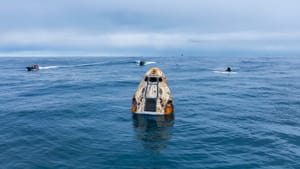
Feb 9, 2024
Axiom-3 crew returns to Earth!
Axiom Space's third commercial mission to the International Space Station has returned to Earth on the 9th of February. The mission launched back on the 18th of January from Launch Complex 39A, at Cape Canaveral in Florida, with SpaceX's Falcon 9 rocket carrying a Crew Dragon spacecraft with the crew inside.
The crew spent approximately eighteen days aboard the International Space Station performing various experiments, which Axiom Space lists here.

Axiom-3 was also the first all-European commercial astronaut mission to the International Space Station, as well as the first time an astronaut from Türkiye has been to space.
Who was onboard Axiom-3?

Michael López-Alegría, from the United States, was the Commander of the Axiom-3 mission for his sixth trip to space. He has previously flown on the following missions: STS-73, STS-92, and STS- 113, and Soyuz TMA-9.
Walter Villadei, from Italy, was the Pilot of the Axiom-3 mission for his second trip to space. He has previously flown to space on the Galactic 01 mission with Virgin Galactic.
Alper Gezeravcı, from Türkiye, was one of the Mission Specialists of the Axiom-3 mission for his first trip to space. He is also currently serving as a fighter pilot with the Turkish Air Force having flown the following aircraft: T-41, SF-260, T-37, T-38, F-5, KC-135, and F-16.
Marcus Wandt, from Sweden, was the second Mission Specialist of the Axiom-3 mission also for his first trip to space. He has been an astronaut with the European Space Agency since November of 2022.
What is Crew Dragon?

Crew Dragon, or Dragon 2, is a partially reusable spacecraft developed by SpaceX. The primary use for Crew Dragon is to send crew to and from the International Space Station. SpaceX has also flown a free flight of the spacecraft for the Inspiration4 mission and is planning another called Polaris Dawn in the summer of 2024.
Crew Dragon consists of the capsule and trunk. The trunk is used to store unpressurized cargo as well as have solar panels mounted on one side, to generate power, and radiators on the other, to dissipate heat generated inside. The trunk is not reused and burns up in the atmosphere after each mission. The capsule is where the crew will be during launch, landing, and while on their way to the International Space Station. Unlike the original Dragon capsule, the Crew Dragon capsule has a launch abort system consisting of eight SuperDraco engines. The capsule also has a nosecone that will fold out of the way in space to protect the docking hardware and forward-facing thrusters during launch and landing.



